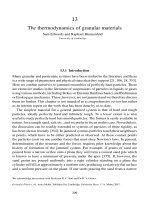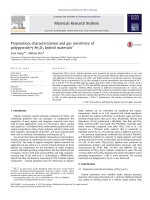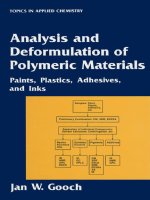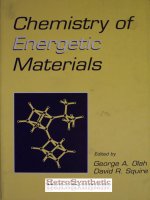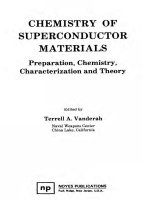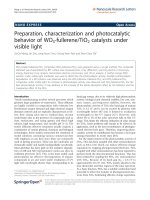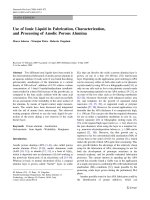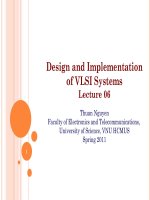chemistry of superconductor materials; preparation, chemistry, characterization and theory, vanderah, 839pp
Bạn đang xem bản rút gọn của tài liệu. Xem và tải ngay bản đầy đủ của tài liệu tại đây (37.81 MB, 839 trang )
Copyright e 1992 by Noyes Publications
No part of this book may be reproduced or utilized in
any form or by any means, electronic or mechanical,
including photocopying, recording or by any informa-
tion storage and retrieval system, without permission
in writing from the Publisher.
Library of Congress Catalog Card Number: 90-27624
ISBN: O-8155-1279-1
Printed in the United States
Published in the United States of America by
Noyes Publications
Mill Road, Park Ridge, New Jersey 07656
10987654321
Library of Congress Cataloging-in-Publication Data
Chemistry of superconductor materials : preparation, chemistry,
characterization and theory / edited by Term11 A. Vanderah.
p. cm.
Includes bibliographical references and index.
ISBN O-8155-1279-1 :
1. Superconductors-Chemistry. I. Vanderah, Terre11 A.
QC611.97.C54C48 1991
.537.6’23-&20
90-27624
CIP
For Jumbo Wells
MATERIALS SCIENCE AND PROCESS TECHNOLOGY SERIES
Editors
Rointan F. Bunshah, University of California, Los Angeles (series Editor)
Gary E. McGuire, Microelectronics Center of North Carolina (series Editor)
Stephen M. Rossnagel, IBM Thomas J. Watson Research Center
(Consulting Editor)
Electronic Materials and Process Technology
DEposmoN TEcHNoLoGlEs FCX FILMS AND CCXllNG!k by Rointan F. Bunshah et al
CHEMK%L VAPOR EPOSTKM FOR m by Arthur Sherman
SEMKX)NDUCTORMATEFUMBANDP#XTSS~YHANDBOOK:edited by
Gary E. McGuire
HYBRD MlCROCtRCUCT TEcHNou)(iY HANDBOOK: by James J. Licari and Leonard R.
Enlow
HANDBOOKOFTHfNFllMOEPOSmONPROCESSESANDTH=HNIQUES:editedbyKlaus
K. Schuegraf
-BEAM-
AND EPlTAXYz by Toshinori Takagi
MFFUSK)NPHENOMENAINTHiNFli_MBANDMICROELECTRONK=MATEFU_Seditedby
Devendra Gupta and Paul S. Ho
HANDBOOK OF CONTAMEuTK)N m IN m edited by Donald
L. Tolliver
HnNDBooKoFK)NBEAM
pRocEssp3G TH;HNouxjy: edited by Jerome J. Cuomo,
Stephen M. Rossnagel, and Harold R. Kaufman
cHARAcTEFIIuTK)NoF-mMA-
\Ibkrme 1: edited by Gary E.
McGuire
HANDXXXOFPLSMA
m TEcHNou)(jy: edited by Stephen M. Rossnagel,
Jerome J. Cuomo, and William D. Westwood
HANDBOcxoF-#3BluCcx
TH;HNouxiy edited by William C. O’Mara,
Robert B Herring, and Lee P. Hunt
HANDBOOK OF KXYMER CQATfMGB m ELH=TRoNK=s: by James J. Licari and Laura
A. Hughes
-oFBPurrER
DEposmoN TH=HNouxiy: by Kiyotaka Wasa and Bhigeru
Hayakawa
HANDBOOK OF Vf_!3 MK;RoI-mK)(jRApm: edited by William B. Glendinning and John
N. Helbert
CHEMISTRY OF supERcoNoucToR MATEWALS: edited by Terrell A Vanderah
CHEMCALVApoRDEKBTKMffTUWSiENANDTWG!SEN
SLClDES by John E.J.
Bchmitz
(continued)
vii
viii Series
Ceramic and Other Materials-Processing and Technology
SoNELTECHNOUXjYFOR~FlUIIS,flBERS.PFIEFOFIMS. -ANo
spH=uLTy SHAPES edited by Lisa C. Klein
FIBER FMNFOFKXI CEf3AMC m by K.S. Mazdiyasni
AmMNCEDCERAMC~AND
TEcHNou)(jy-volume 1: edited by Jon G.P.
Binner
FWCTK)NANLlWEAFlTRANSmONSOfMATEMALSzbyPeterJ.Blau
!NOCK WAVES FOR HDUSTMAL
APPLKXTKNJS edited by Lawrence E. Murr
SPECIALMELTNGAND
m TEcHNouxjKs edited by G.K. Bhat
coFwosK)N OF GIMS, CERAMKX AND CEFMMKZ SUpERcoNwcToRs: edited by
David E. Clark and Bruce K. Zoitos
Related Titles
ADHEWES TEcHNou)(jY HANDBOCX by Arthur H. Landrock
HANDBOOK OF lHEFMXi3 RA!3KZS edited by Sidney H. Goodman
SURFACE -MLON TECHNKXJES FOR ADHESIVE BONDING: by Raymond F.
Wegman
FOFMUlATlNG pLAsncsANDoLAsToMERsBYcoMpuTER
by Ralph D. Hermansen
Contributors
Brian G. Bagley
Bellcore
Red Bank, New Jersey
Phillipe Barboux
Universite Pierre et
Marie Curie
Paris, France
Jeremy K. Burdett
The James Franck Institute
The University of Chicago
Chicago, Illinois
Robert J. Cava
AT&T Bell Laboratories
Murray Hill, New Jersey
Bertrand L. Chamberland
University of Connecticut
Storrs, Connecticut
Anthony K. Cheetham
University of Oxford
Oxford, England
Ann M. Chippindale
University of Oxford
Oxford, England
Pratibha L. Gai
E.I. du Pont de Nemours
and Co., Inc.
Wilmington, Delaware
Daniel Groult
Centre Des Materiaux
Supraconducteurs
ISMRA
Caen Cedex, France
Daniel C. Harris
Naval Weapons Center
China Lake, California
Maryvoune Hervieu
Centre Des Materiaux
Supraconducteurs
ISMRA
Caen Cedex, France
Anthony C.W.P. James
AT&T Bell Laboratories
Murray Hill, New Jersey
Donald H. Liebenberg
Office of Naval Research
Arlington, Virginia
Claude Michel
Centre Des Materiaux
Supraconducteurs
ISMRA
Caen Cedex, France
Donald W. Murphy
AT&T Bell Laboratories
Murray Hill, New Jersey
Michael L. Norton
University of Georgia
Athens, Georgia
Bernard Raveau
Centre Des Materiaux
Supraconducteurs
ISMRA
Caen Cedex, France
xv
xvi Contributors
Anthony Santoro
J. Steven Swinnea
National Institute of
The University of Texas
Standards and Technology
at Austin
Gaithersburg, Maryland
Austin, Texas
Lynn F. Schneemeyer
AT&T Bell Laboratories
Murray Hill, New Jersey
Jean Marie Tarascon
Bellcore
Red Bank, New
Arthur W. Sleight
Oregon State University
Corvallis, Oregon
Hugo Steinfink
The University of Texas
at Austin
Austin, Texas
Charles C. Torardi
E.I. du Pont de Nemours
and Co., Inc.
Wilmington, Delaware
Terre11 A. Vanderah
Naval Weapons Center
China Lake, California
Stephen A. Sunshine
AT&T Bell Laboratories
Murray Hill, New Jersey
Eugene L. Venturini
Sandia National Laboratories
Albuquerque, New Mexico
NOTICE
To the best of the Publisher’s knowledge the information
contained in this publication is accurate; however, the
Publisher assumes no responsibility nor liability for errors or
any consequences arising from the use of the information
contained herein. Final determination of the suitability of any
information, procedure, or product for use contemplated by
any user, and the manner of that use, is the sole
responsibility of the user.
The book is intended for informational purposes only. The
reader is warned that caution must always be exercised when
dealing with chemicals, products, or procedures which might
be considered hazardous. (Particular attention should be
given to the caution notes in chapters 6 and 16.) Expert
advice should be obtained at all times when implementation
is being considered.
Mention of trade names or commercial products does not
constitute endorsement or recommendation for use by the
Publisher.
Foreword
The word “Chemistry” in the title of this book just radiates a host of
associations, questions, and relations. What role is there for the science of
molecules in the study of a phenomenon that is basically physical? Why were
these remarkable compounds not made before? Do we need to understand a
physical property to make advances with it?
You cannot investigate the properties of a molecule before making it. Oh,
some theoretical colleagues of mine would argue otherwise, and they do have
a case for some small molecules in the interstellar medium, and a few other
isolated successes as well. But for molecules of reasonable size one needs the
beast in hand before one can tame it. And who are the experienced designers
of molecules? Chemists, of course. Not all of them, mind you. Physical
chemists have a lot of trouble making molecules, and physicists-well, they’re
just not supposed to be good at this archetypical chemical enterprise, the
transformation of recalcitrant matter from one bonding arrangement to
another.
So here is the first surprise of the new developments of the eighties in
superconductivity. Complex materials, compounds of as many as seven
elements, were (and are) made by people who weren’t supposed to be good
at making them, physicists in particular. To some chemists this came as a
shock. And to say that it was easy, that this solid state synthesis, the “shake-
and-bake” methodology, is trivial, only allows the question to form in our
minds, “If so, why did chemists not discover them earlier?”
Perhaps they did, or could have, come close, except that they didn’t
possess the capability to make the crucial measurements indicating
superconductivity. You might think “never again,” that given what we have
learned of the high T, materials, no chemist could possibly avoid searching for
superconductivity in newly synthesized conducting materials. But that is not so.
About 90% of the interesting materials that I, as a theoretician, have picked
up from the literature of the last three years, remain untested. Only their
synthesis and structure are reported, perhaps the briefest indication of electric
and magnetic properties. Obviously the community has been sensitized, but
lags behind in exploring the richness it itself wrought. Either the instruments
are not available, or people do not have friends cooperative enough to do the
measurements, compartmentalized as our specialized disciplines often are. Or
they, the synthesizers, remain content in the paradigmatic exercise of their
molecular trade, unwilling to be bothered by Brillouin zones or the art of
attaching leads. And, just to set the balance right, many of their more
progressive friends, the fortunate ones to whom those measurements come
easy, intellectually and instrumentally, would rather spend their time making
ix
x Foreword
a tiny stoichiometric wrinkle of a perturbation than look at a phase that bears
no resemblance to known successes.
Did we really understand superconductivity before 1985? And, does one
need to understand the physics and chemistry of the phenomenon today,
before making new, better materials? I think the answer to both these
questions is “no and yes.” And the questions and answers addressed in this
new chemistry of superconductivity, in this book, are revealing, probing what
we mean by “understanding.”
The scientific community at large has bought into reductionism as the
ideology of understanding. A phenomenon in chemistry is said to be
understood when it is reduced to the underlying physics, when we know the
physical mechanism(s) contributing to it, how they vary with macroscopic or
microscopic perturbations. In that sense the BCS theory did provide a detailed
understanding of the physics of superconductivity. But in another sense we
should have known all along that we did not really understand the
phenomenon. For we could never predict whether a given material would be
superconducting or not, not to speak of its T,. “Oh,” we would say-“if only we
could calculate the electron-phonon coupling exactly,” and some day, in that
millennium of the clever theoretical chemist coupled to whatever will come
beyond the supercomputer, we would indeed be able to do so. But until then,
well, we had to make do with the intuition of people such as the late Bernd
Mattias.
I think we didn’t understand superconductivity, in the sense of being able
to use the physics to build a molecule with predictable properties. Our
understanding was deconstructive or analytical rather than constructive or
synthetic. I think there is a difference between these modes of understanding.
Do we need to understand superconductivity to make better
superconductors
? Well, I think we do need to have (a) the systematic
experimental experience requisite for intuition to develop; (b) a set of
theoretical frameworks, none necessarily entirely logical or consistent, to
provide us with the psychological incentive to do the next experiment; (c) a
free exchange of results; (d) people wishing to prove others wrong as well as
themselves right; (e) the material resources to investigate what needs
investigating. Together these criteria make up the working system of science,
not the catechism of how science should work. Note that understanding, in the
reductionist sense, enters only in (b), and even there not in a controlling way.
The frameworks of understanding that will move us forward can be simplistic
chemical ones, just as much as fancy couplings in some weirdly truncated
Hamiltonian. Let’s take a look, ten years from now, at what principles will
have guided the discoverers, chemists and physicists, of the materials that may
make this book obsolete.
Cornell University
Ithaca, New York
August, 1990
Roald Hoffmamr
Preface
The post-1986 explosion in research on complex cuprates found to be
superconducting above the boiling point of liquid nitrogen has sharply
focussed our growing need to attack scientific frontiers using multi- and
interdisciplinary approaches. Nearly four years of intensive research have
produced several new families of compounds with Tc values as high as 125 K,
yet both physicists and chemists remain largely baffled by these amazing
oxides.
Our lack of theoretical understanding of high-temperature
superconductivity is underscored by a continuing and profound inability to
predict its appearance; our lack of chemical understanding, by the notorious
difficulties encountered in the preparation of samples with reproducible
chemical compositions, structures, and superconductive properties. This
inherently difficult situation, compounded by a breakneck pace of research
unleashed by the historical importance of Bednorz and Mueller’s
breakthrough, quite predictably resulted in a veritable flood of detailed studies
on the physical properties of impure, ill-characterized materials. Not since the
semiconductor revolution has there existed such a well-defined need for
chemists and physicists to collaborate in the chemical tailoring and
fundamental understanding of electronically important solids-clearly, the
tantalizing payoffs loom large for the advancement of technology as well as
fundamental knowledge.
Concomitant with a more reasonable pace of research has come a general
acceptance that progress in our understanding and control of high-temperature
superconductivity hinges on systematic and meaningful investigations of the
intrinsic properties of high-quality, well-characterized samples. However, the
chemical-structural nature of these unusual compounds; e.g., thermodynamic
instability, nonstoichiometry, and, for the cuprates, two-dimensional structures
notoriously prone to defects and intergrowths, has presented the synthesis with
a formidable challenge to develop easily reproducible protocols that yield pure
materials with optimal superconducting properties. It was quickly learned that
subtle differences in reaction conditions and sample history could, and often
did, drastically affect superconducting properties. Yet, the kinetic factors
involved in solid state reactions are not well understood, measured, or
controlled. Furthermore, the relationship of defects and other “micro-scale”
variations in chemistry and structure to the superconducting properties is not
yet clear. A striking example is the peculiar chemistry of the “n-type”
superconductor Nd 1.&e,-,15Cu04:
neither polycrystalline samples nor single
crystals (usually) superconduct after initial formation of the structure in air.
Upon a high-temperature anneal in an inert gas, however, superconductivity
above 20 K can (frequently) be observed. The chemical and structural changes
xi
xii Preface
induced by the inert-gas anneal are so subtle that, despite intense research
since the discovery of the compound almost two years ago, a clear picture of
the changes that we can associate with the “turning on” of superconductivity
still eludes us.
The purpose of this book is to address this difficult starting point for
every experimentalist-the sample. In this regard, we have endeavored to
produce a useful reference text for those interested in the preparation, crystal
chemistry, structural and chemical characterization, and chemistry-structure-
property relations of these fascinating materials. This book has in large part
been written by members of that subspecies of inorganic chemistry called solid
state chemistry, a specialization that evolved during the heyday of the
semiconductor device, and which now seems uniquely suited for the
challenging chemistry of high-T, compounds. Hence, the approach taken to
the material is predominantly that of the solid state chemist. We are grateful,
however, that two of our physicist colleagues consented to keep company with
us and contribute chapters in their own specialties concerning the proper
measurement and interpretation of transport and magnetic properties.
The book is extensively referenced and will hopefully serve the
experimentalist as a day-to-day source of information (e.g., synthetic
procedures, crystal structures, and tables of X-ray diffraction data) as well as
a review of the literature into 1990. The introductory chapter describes the
detailed chemical history of superconductivity, beginning with the first
observation of the phenomenon in the element Hg in 1911. Thereafter, the
chapters are partitioned into three sections emphasizing synthesis and crystal
chemistry, sample characterization, and chemistry-structure-property relations.
The section on Structural and Preparative Chemistry contains ten chapters,
three of which, using different approaches, describe the detailed crystal
chemistry of the various cuprate systems. Three chapters discuss synthesis
exclusively and include a basic review of solid state synthetic methods as well
as detailed procedures for the preparation of single-crystal and polycrystalline
samples of the various superconducting systems. Four other chapters in this
section include both synthetic and structural discussions of YBa2Cu307related
compounds, the non-cuprate Ba-K-Bi-0 and Ba-Pb-Bi-0 systems, and the “n-
type” superconductors derived from Nd&u04. The section entitled Sample
Characterization contains six chapters. A basic review of phase identification
by X-ray diffraction is followed by a compilation of single-crystal structural
data and calculated powder patterns for nearly all of the superconducting
cuprates. Two chapters cover structural and chemical characterization by
electron microscopy, a technique particularly important for these typically
defective, nonstoichiometric compounds. The remaining three chapters cover
wet chemical methods and the measurement of transport and magnetic
properties. In the last section of the book, two chapters discuss chemistry-
structure-property relationships from the point of view of the chemist. Finally,
we have included two appendices that will hopefully aid the reader in finding
synthetic procedures for desired phases as well as review articles and texts in
Preface xiii
superconductivity and solid state chemistry.
I am most grateful to the contributors of this book, every one of whom
took the time to write a fine chapter in a timely, enthusiastic fashion. As
editor, it has been my privilege to work with internationally recognized leaders
in the field of solid state chemistry and superconductivity. Above all, I thank
the chapter-writers for all that I have learned from them during the detailed
reading of each manuscript. The tireless efforts of George Narita were
responsible for both the genesis and realization of this project, and I will
always cherish the unwavering support and encouragement given to me by
Charlotte Lowe-Ma and David Vanderah.
China Lake, California
October 9, 1990
Terrell A. Vanderah
Contents
PART I
INTRODUCTION
1. HISTORICAL INTRODUCTION AND CRYSTAL
CHEMISTRY OF OXIDE SUPERCONDUCTORS
2
Bemand L. Chamberland
1. Introduction
2
1.1 Discovery of Superconductivity
4
1.2 Superconductivity-A Brief Survey
4
1.3 Search Within the Chemical Elements-
Pure Metals and the Elements
10
1.4 An Overview of the Superconducting Binary
Alloy Systems
11
1.5 Ventures Into Ceramic Materials-Binary
Borides, Carbides, and Nitrides
15
1.6 Ventures Into Ceramic Oxides-Simple Binary
and Ternary Systems
17
1.7 Major Milestones in Oxide Superconductivity
Research
21
1.8 Ternary Chemical CompoundsComplex Borides
and Sulfides
23
1.9 Non-Transition Metal Systems-(SN), and
Others
25
1.10 Organic Superconductors
28
2. Studies on Superconducting Oxides Prior to 1985
30
2.1 Studies of Superconducting Oxides with the
Sodium Chloride Structure
30
xvii
xviii Contents
2.
2.2
Studies of Superconducting Oxides with the
Perovskite-Type Structure . . . . . . . . . . . . . . . . . . 34
2.3
Studies of Superconducting Oxides with the
Spine1 Structure . . . . . . . . . . . . . . . . . . . . . . . . . 49
2.4
Post-1985 Entry of Copper Oxide
Superconductors . . . . . . . . . . . . . . . . . . . . . . . . . 52
3. Structural Features and Chemical Principles in
Copper Oxides . . . . . . . . . . . . . . . . . . . . . . . . . . . . . . . 52
3.1
The Fascinating Chemistry of Binary and
Ternary Copper Oxides . . . . . . . . . . . . . . . . . . . 52
3.2 Copper to Oxygen Bond Distances-Ionic Radii . . 55
4. Physical Property Determination on Ternary Copper
Oxides-Studies on Copper Oxide Systems Prior to
1985
. . . . . . . . . . . . . . . . . . . . . . . . . . . . . . . . . . . . . . 61
4.1
Studies on La&u04 and Its Derivatives . . . . . . . 61
4.2 Startling Discovery by MiiUer and Bednorz . . . . . 70
4.3
Corroboration of the Discovery and Further
Developments
. . . . . . . . . . . . . . . . . . . . . . . . . . 76
4.4 Major Copper Oxide Superconductors Presently
Being Investigated . . . . . . . . . . . . . . . . . . . . . . . 84
5. Chemical SubstitutIons-CrystaI Chemistry . . . . . . . . . . 84
5.1
Chemical Substitutions in the La&u04
Structure . . . . . . . . . . . . . . . . . . . . . . . . . . . . . . 84
5.2 Chemical Substitutions in the Perovskite
Structure . . . . . . . . . . . . . . . . . . . . . . . . . . . . . . 84
6. References . . . . . . . . . . . . . . . . . . . . . . . . . . . . . . . . . . 93
PART II
STRUCTURAL AND PREPARATIVE CHEMISTRY
THE COMPLEX CHEMISTRY OF SUPERCONDUCTIVE
LAYERED CUPRATES
. . . . . . . . . . . . . . . . . . . . . . . . . . . . . . 106
Bernard Raveau, Claude Michel, Mayvonne Hervieu,
Daniel Groult
1. The Structural Principles . . . . . . . . . . . . . . . . . . . . . . 106
2. Oxygen Non-Stoichiometry and Methods of
Synthesis . . . . . . . . . . . . . . . . . . . . . . . . . . . . . . . . . .
114
3. Extended Defects . . . . . . . . . . . . . . . . . . . . . . . . . . . . 124
3.1
Defects in YBa,Cu,O, . . . . . . . . . . . . . . . . . . . 124
3.2 Intergrowth Defects iu ThaIIium Cuprates . . . . . 129
4. Incommensurate Structures and Lone Pair Cations . . 133
5. Concluding Remarks . . . . . . . . . . . . . . . . . . . . . . . . . 139
6. References . . . . . . . . . . . . . . . . . . . . . . . . . . . . . . . . . 141
Contents xix
3. DEFECTIVE STRUCTURES OF Ba2YCu30, AND
BazYCu
*
0, (M = Fe, Co, AI, Ga, . . .) . . . . . . . . . . . . . . . .
146
Anthony antoro
1. Intruduction . . . . . . . . . . . . . . . . . . . . . . . . . . . . . . . 146
2. Discussion of the Structure of &YCU~O,~ . . . . . . . . 147
2.1 Structural Changes as a Function of Oxygen
Stoichiometry . . . . . . . . . . . . . . . . . . . . . . . . . . 150
2.2 Twmniq, Twin Boundaries and Model of the
Structure of Ba,YCu,O,., . . . . . . . . . . . . . . . . .
154
2.3 Oxygen Vacancy Ordering in Ba,YCu,O, . . . . . 161
2.4
Mechanisms of Oxygen Elimination From the
Structure of Ba2YCus0, . . . . . . . . . . . . . . . . . .
169
2.5
Metal Substitutions . . . . . . . . . . . . . . . . . . . . . . 174
3. References . . . . . . . . . . . . . . . . . . . . . . . . . . . . . . . . . 185
4. CRYSTAL CHEMISTRY OF SUPERCONDUCTORS AND
RELATED COMPOUNDS . . . . . . . . . . . . . . . . . . . . . . . . . . . . 190
Anthony Santoro
1. Introduction . . . . . . . . . . . . . . . . . . . . . . . . . . . . . . . 190
2. Description of Layered Structures . . . . . . . . . . . . . . . 191
2.1
Structural Types of Superconductors . . . . . . . . . 200
2.2 Compounds with the Perovskite Structure . . . . . 201
2.3 Compounds with Crystallographic Shear . . . . . . 205
2.4 Compounds with the Rocksalt-Perovskite
Structure . . . . . . . . . . . . . . . . . . . . . . . . . . . . . 213
3. References . . . . . . . . . . . . . . . . . . . . . . . . . . . . . . . . . 220
5. CRYSTAL GROWTH AND SOLID STATE SYNTHESIS
OF OXIDE SUPERCONDUCTORS
224
Lynn F. Schneemeyer
1. Overview
224
2. Solid State Synthesis
224
2.1
Oxide Synthesis
225
2.2
Preparation of Samples Containing Volatile
Constituents
227
2.3
Ceramic Characterization
228
3. Bulk Crystal Growth
229
3.1 Introduction to the Growth of Single Crystals . . 229
3.2
Flux Growth
232
3.3
Growth of Superconducting Oxides
236
3.4
Characterizing Single Crystals
247
4. References
250
6. PREPARATION OF BISMUTH- AND THALLIUM-
xx Contents
BASED CUPRATE SUPERCONDUCTORS
. . . . . . . . . . . . . . . 257
Stephen A. Sunshine and Terre11 A. Vamierah
1. Introduction . . . . . . . . . . . . . . . . . . . . . . . . . . . . . . . 257
2. Synthetic Methods . . . . . . . . . . . . . . . . . . . . . . . . . . . 263
3. Synthesis of Bi-Based Cuprate Superconductors . . . . . 265
3.1 Single Cu-0 Layer Phase [22Ol], T, = 10 K . . . 265
3.2
Cu-0 Double Layers [2212], T, = 80 K . . . . . . . 266
3.3
Triple Cu-0 Layers [2223], T, = 110 K . . . . . . . 270
4. Synthesis of Thallium-Based Cuprate
Superconductors . . . . . . . . . . . . . . . . . . . . . . . . . . . . 273
4.1 Preparations in Air or Lidded Containers . . . . . 273
4.2 Preparations in Hermetically Sealed
Containers . . . . . . . . . . . . . . . . . . . . . . . . . . . . 275
4.3
Preparations Under Flowing Oxygen . . . . . . . . . 279
5. Conclusion
. . . . . . . . . . . . . . . . . . . . . . . . . . . . . . . . 280
6. References . . . . . . . . . . . . . . . . . . . . . . . . . . . . . . . . . 281
7. SYNTHESIS OF SUPERCONDUCTORS THROUGH
SOLUTION TECHNIQUES
Phillipe Barboux
1. Introduction
1.1
Ceramic Processing
1.2
Interest in Solution Techniques
1.3
The Different Solution Techniques
2. Synthesis Procedures
2.1
General Principles of Synthesis
2.2 The Different Solution Processes
2.3
The Different Precursors
2.4
Thermal Processing
2.5
Carbon-Free Precursors
3. Conclusion
4. References
287
287
287
288
289
289
290
292
293
298
302
305
306
8. CATIONIC SUBSTITUTIONS IN THE HIGH T,
SUPERCONDUCTORS
310
Jean Marie Tarascon and Brian G. Bag&
1. Introduction
310
2. Materials Synthesis
313
3. Results
314
3.1
La.&+,CuO,
314
3.2
yBa2Cu,0,
322
3.3
Bi2Sr,Ca,,,C~0,
328
4. Discussion
335
5. References
342
Contents xxi
9. THE CHEMISTRY OF HIGH T, IN THE BISMUTH
BASED OXIDE SUPERCONDUCTORS BaPbl_&O, AND
Ba,_wiO,
347
Michael L. Norton
. Introduction
347
2. Theoretical Underpinnings of Bismuthate
Research
348
3. Crystallography
354
4. Materials Preparation
355
4.1
Bulk Growth
355
4.2
Crystal Growth
356
4.3
Thin Film Preparation
358
5. Physical Properties
359
5.1
Electrical Transport Properties
359
5.2
Magnetic Properties
361
5.3
Optical and Infrared Properties
361
5.4
Specific Heat
362
5.5
Pressure Effects
363
5.6
Isotope Effects
364
6. Theoretical Basis for Future Bismutbate
Research
365
7. Applications
367
8. Conclusion
369
9. References
369
10. CRYSTAL CHEMISTRY OF SUPERCONDUCTING
BISMUTH AND LEAD OXIDE BASED PEROVSKITES
380
Robert J. Cava
1. Introduction
380
2. BaBiO,
382
3. BaPbO,
392
4. BaPb,_Bi,O,
3%
5. BaPbl_$bxO,
406
6. Ba,_$$iO,
410
7. Conclusion
419
8. References
422
11. STRUCTURE AND CHEMISTRY OF THE ELECTRON-
DOPED SUPERCONDUCTORS
427
Anthony C.W.P. James and Donald W; Murphy
1. Introduction
427
2. Tbe T’-Nd,CuO, Structure
428
3. Systematics of Electron Doping
431
4. Chemical Synthesis and Analysis
437
xxii Contents
5. Single Crystals and Thin Films
6. Summary
7. References
PART III
SAMPLE CHARACTERIZATION
12. X-RAY IDENTIFICATION AND CHARACTERIZATION OF
COMPONENTS IN PHASE DIAGRAM STUDIES
J. Steven Swinnea and Hugo Steinfink
1. The Gibbs Phase Rule
2. Phase Diagrams
3. Phase Diagram Studies
4. X-Ray Diffraction
5. Tying It All Together
6. References
13. STRUCTURAL DETAILS OF THE HIGH T, COPPER-
BASED SUPERCONDUCTORS
Charles C. Torardi
. Introduction
2. Structures of the Perovskite-Related YBa,Cu,O,
YBa#u40s, and Y.$a.,Cu701s Superconductors
2.1 123 Superconductor
2.2 124 and 247 Superconductors
3. Structures of the Perovskite/Rock Salt
Superconductors
3.1 Lanthanum-Containing Superconductors
3.2 Bismuth-Containing Superconductors
3.3 Thallium-Containing Superconductors
3.4 Thallium-Lead Containing Superconductors
4. Structures of Pb-Containiug Copper-Based
Superconductors
5. Distortions in the Rock Salt Layers and Their
Effect on Electronic Properties
6. Correlations of T, with In-Plane Cu-0 Bond Length . .
7. Tables of Crystallographic Information
8. References
14. CHEMICAL CHARACTERIZATION OF OXIDE
SUPERCONDUCTORS BY ANALYTICAL ELECTRON
MICROSCOPY . . . . . . . . . . . . . . . . . . . . . . . . . . . . . . . . . . . .
Anthony K Cheetham and Ann M. Chippindale
442
444
445
450
451
454
464
465
476
4&I
485
485
488
488
490
490
490
491
493
495
495
4%
500
501
541
545
Contents xxiii
1. Introduction
545
2. Analytical Electron Microscopy: A Brief Survey
547
3. Experimental Method.
548
4. Data Collection and Analysis of Standards
551
5. Analysis of the “22l2” Compound (36)
554
6. Discussion
555
7. References
558
15. ELECTRON MICROSCOPY OF HIGH TEMPERATURE
SUPERCONDUCTING OXIDES
561
Ratibha L. Gai
. Introduction
561
2. Techniques of High Resolution Transmission
Electron Microscopy @REM), Transmission EM
(TEM) Diffraction Contrast, and Analytical
EM (AEM)
562
2.1 HREM
563
2.2 TEM Diffraction Contrast
564
2.3 High Spatial Resolution Analytical EM
564
3. MicrostructuraI and Stoichiometric Variations
566
3.1 Substitutional Effects in La-Based Super-
conductors
566
3.2 Y-Based Superconductors
570
3.3 Substitution of Ca in Tetragonal YBa,Cu,O,
576
3.4 Bi-Based Superconductors
578
4. TI-Based Superconductors
589
4.1 Tl-Ba-Ca-Cu-0 Superconductors
591
4.2 (Tl,Pb)-Sr-Ca-Cu-0 Superconductors:
(Tl,Pb)Sr2CaCu207 (II = 2) and
597
5
.
kfe~~~sPb)Sr,Ca,Cu,O, (n = 3)
.
16. OXIDATION STATE CHEMICAL ANALYSIS . . . . . . . . . . . . . 609
Daniel C. Hanis
1. Superconductors Exist in Variable Oxidation
states . . . . . . . . . . . . . . . . . . . . . . . . . . . . . . . . . 609
. . AudWe Don’t KuowWhat Is Oxidized . . . . . . . . . 610
2. Analysis of Superconductor Oxidation State
by RedoxTitration . . . . . . . . . . . . . . . . . . . . . . . . . . . 611
2.1 Iodometric Titration Procedure . . . . . . . . . . . . . 614
2.2 Citrate-Complexed Copper Titration
Procedure . . . . . . . . . . . . . . . . . . . . . . . . . . . . 616
3. Reductive Thermogravimetric Analysis . . . . . . . . . . . . 616
4. Oxygen Evolution in Acid . . . . . . . . . . . . . . . . . . . . . . 619
xxiv Contents
5. Eiectrochemicai Investigation of Super-
Conductor Oxidation State
621
6. Assessment of Anaiytical Procedures
624
7. References
624
17. TRANSPORT PHENOMENA IN HIGH TEMPERATURE
SUPERCONDUCTORS
627
Donald H. Liebenberg
1. Introduction
627
2. Resistivity Measurement
627
2.1
Survey of Results of Resistivity Measurements . . 632
2.2
Theoretical Notes
637
3. Critical Current Density Measurements
639
3.1
Measurement of Critical Current
639
3.2 Results of Critical Current Measurements
645
4. Dissipation in the Intermediate State
652
5. Thermal Conductivity
656
6. Thermopower
657
7. Hall Effect
658
8. Tunneling Transport
660
8.1
Josephson Effect
662
8.2
Tunneling Results
663
9. References
667
18. STATIC MAGNETIC PROPERTIES OF HIGH-
TEMPERATURE SUPERCONDUCTORS . . . . . . . . . . . . . . . . . 675
Eugene L. Venfurini
1. Introduction . . . . . . . . . . . . . . . . . . . . . . . . . . . . . . . 675
2. Low-Field Measurements . . . . . . . . . . . . . . . . . . . . . . 677
2.1
Normal State Response . . . . . . . . . . . . . . . . . . 677
2.2 Diamagnetic Shielding by a Superconductor . . . 681
2.3
Magnetic Flux Exclusion and Expulsion . . . . . . . 687
3. High-Field Measurements: Hysteresis Loops
and Critical Current Deasity . . . . . . . . . . . . . . . . . . . 691
4. Magnetization Relaxation or Giint Flux Creep . . . . . . 6%
5. Problems with Porous and Weak-Linked Ceramics . . . 700
6. Concluding Remarks . . . . . . . . . . . . . . . . . . . . . . . . . 705
7. References . . . . . . . . . . . . . . . . . . . . . . . . . . . . . . . . . 706
PART IV
STRUCTURE-PROPERTY CONSIDERATIONS
19. ELECTRONIC STRUCTURE AND VALENCY IN OXIDE
SUPERCONDUCTORS
. . . . . . . . . . . . . . . . . . . . . . . . . . . . . . 714
Contents xxv
Arthur W Sleight
1. Introduction
714
2. Mixed Valency and the Partially Fiiied Band
714
3. Vaient States vs ReaI Charges
718
4. Stabilization of 0” and Hi Oxidation States
720
5. Polarizibility
721
6. Defects aud Inhomogeneities
723
7. Stability
726
8. T, Correlations
729
9. Mechanism for High T,
731
10. References
733
20. ELECTRON-ELECTRON INTERACTIONS AND THE
ELECTRONIC STRUCTURE OF COPPER OXIDE-
BASED SUPERCONDUCTORS . . . . . . . . . . . . . . . . . . . . . . . . 735
Jeremy K Bur&tt
1. Introduction
. . . . . . . . . . . . . . . . . . . . . . . . . . . . . . . 735
2. One- and ‘hvo-Electron Terms in the Energy . . . . . . . 736
3. Energy Bands of Solids . . . . . . . . . . . . . . . . . . . . . . . 748
4. The Peierls Distortion . . . . . . . . . . . . . . . . . . . . . . . . 753
5. Autiferromaguetic Insulators . . . . . . . . . . . . . . . . . . . 756
6. Electronic Structure of Copper Oxide Super-
conductors . . . . . . . . . . . . . . . . . . . . . . . . . . . . . . . . . 759
7. The Orthorhombic-Tetragonai Transition in 2-l-4 . . . . 766
8. Superconductivity and Sudden Electron Transfer . . . . 770
9. Some Conclusions . . . . . . . . . . . . . . . . . . . . . . . . . . . 773
10. References . . . . . . . . . . . . . . . . . . . . . . . . . . . . . . . . . 774
APPENDIX A: GUIDE TO SYNTHETIC PROCEDURES . . . . . . . . . 776
APPENDIX B: FURTHER READING IN SUPERCONDUCTIVITY
AND SOLID STATE CHEMISTRY
. . . . . . . . . . . . . . . . . . . . . . . . . 784
FORMULA INDEX . . . . . . . . . . . . . . . . . . . . . . . . . . . . . . . . . . . . . 790
SUBJECT INDEX . . . . . . . . . . . . . . . . . . . . . . . . . . . . . . . . . . . . . . 802
Part I
Introduction
1
Historical Introduction and Crystal
Chemistry of Oxide Superconductors
Bertrand L. Chamberland
1 .O INTRODUCTION
The objectives of this chapter are to introduce the reader to
the interesting and important phenomenon of superconductivity in
various materials. We begin with the original discovery of supercon-
ductivity and proceed to the investigation of the chemical elements,
then metallic alloys, and finally to ceramic and other inorganic
materials which also exhibit this unusual phenomenon. After the brief
overview of discovery and the observation of superconductivity in a
number of substances, we will focus on research studies conducted on
oxide materials. Several oxide systems were investigated during the
early years, but due to experimental temperature limitations, very few
of these materials were found to superconduct above 2 K. This led to
frustration and disappointment for those scientists seeking supercon-
ductivity in the most promising candidates.
The research effort on oxides began in 1933 and our focus will
be on the published results up to 1985, just prior to the major
breakthrough in superconductivity which occurred in the fall of 1986
with the discovery of the Cu-0 superconductors. The critical
parameters for a superconductor are: its critical transition temperature
(here, given on the Kelvin scale), its critical magnetic field (given in
Tesla or Gauss units), and its critical current (given in units of
Amperes). Our presentation is aimed principally on the single
property of critical transition temperature (T,), since it is controlled
2
Historical Introduction and Crystal Chemistry of Oxide Superconductors
3
primarily by the chemical composition and the structural arrangement
of atoms. These two factors are of primary concern to the chemist and
material scientist. The transition temperature can be determined in a
number of ways; by magnetic, electrical, or calorimetric experiments;
and the temperature can be given as the onset of transition, the
mid-point of the transition, or at the terminus of transformation (for
example, when the resistance in the material can no longer be
measured). The T, data presented in this chapter were obtained by any
of those methods mentioned above, and are often those temperatures
reported in the literature. More recently, the T, values are those
obtained at the onset region since these represent the highest tempera-
tures which can readily be reproduced in both the magnetic and
electrical experiments. The original term, high T, superconductivity,
was used to designate a material with a superconducting transition
temperature greater than 18 K, the highest value obtained for the
intermetallic compound NbsSn (T, = 18.07 K) in the late 1950’s. This
temperature approaches the boiling point of liquid hydrogen (20 K),
which could be used as the cryogen instead of liquid helium. Today
the term high T, has taken on a new meaning, where the onset
temperature for superconductivity is greater than 30 K. The overall
chronological development of oxide superconductors will be presented
in a summary fashion. The research on non-oxide systems is present-
ed in a highly abbreviated form, and only a sampling of different
materials will be given to acquaint the reader with some specific
examples of these materials and their transition temperatures, for
comparison with the oxide compounds.
The chemistry of copper, especially in oxide compounds, is
presented from a crysto-chemical viewpoint. The known binary and
ternary compounds are reviewed and the important features of
geometry, covalency, ionic radii, and bond length are discussed in
great depth. This section concludes with a brief description of the
Bednorz and Miller discovery, followed by Chu and co-workers’
important discovery of superconductivity at 95 K in the so-called
“l-2-3” copper-oxide system.
This chapter will exclude all detailed descriptions of physical
properties and experimental results presented in several of the Physics
journals. The theoretical aspects of superconductivity will also be
omitted, as well as the practical application and engineering aspects of
these new materials.
4 Chemistry of Superconductor Materials
1 .l Discovery of Superconductivity
At very low temperatures, the movement of atoms, ions, and
molecules is greatly reduced. As the temperature of a substance is
decreased, the states of matter can change from gas to liquid, and then
to a solid or the condensed state. A technical challenge in the early
1900’s was the liquefaction of all known room-temperature gases to
their liquid state. Research at achieving very low temperatures led the
Danish physicist Heike Kamerlingh Onnes in 1908 to first obtain
liquid helium at 2.18 K. Liquid helium displays many remarkable
properties, one of which was given the name “super-fluidity” by
Kamerlingh Onnes. Superfluidity is a phenomenon by which the liquid
exhibits a completely frictionless flow, which allows it to pass easily
through small holes (less than 10V6 cm in diameter), and to flow up the
walls of any container! The superfluid can rise up the inside walls,
pass over the top edge, and escape by flowing down the outside walls
of the container. The phenomenon of superconductivity was discov-
ered (1) by Kamerlingh Onnes at the University of Leiden in 19 11,
three years after he had achieved the first liquefaction of helium. In
the critical experiment, his students were measuring the (relative)
resistance of solid mercury which was 125 pn at 4.5 K and, on cooling
to lower temperatures, a sharp discontinuity in resistance occurred at
-4.3 K; below this temperature, the resistance in mercury was less
than 3 ~0 (see Figure 1).
Superconductivity is the sudden and complete disappearance
of electrical resistance in a substance when it is cooled below a certain
temperature, called the critical transition temperature, T,.
1.2 Superconductivity- A Brief Survey
The phenomenon of superconductivity, a new state of matter,
has intrigued physicists, metallurgists, electrical engineers, and
material scientists ever since its discovery. In addition to the total loss
of electrical resistance to the passage of a direct current in these
materials, there also occurs an unusual magnetic behavior:
that
tendency to expel a magnetic field from its interior below the T,, this
results in the formation of a perfect diamagnetic material. This effect
allows superconductors to repel magnets and act as magnetic shields
with high efficiency.

